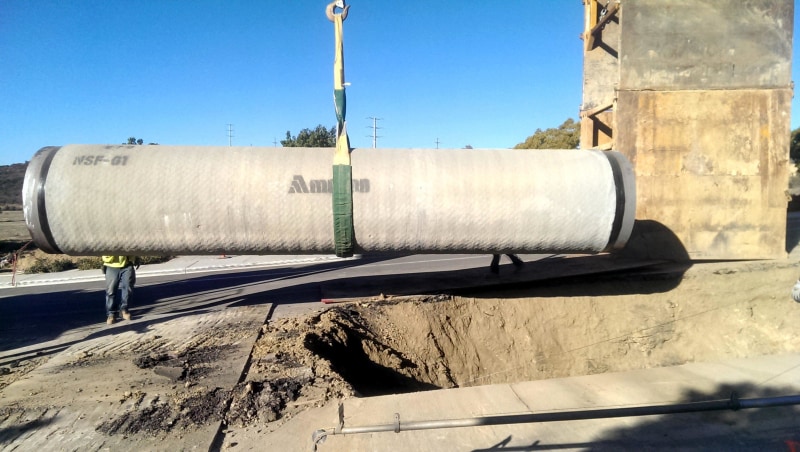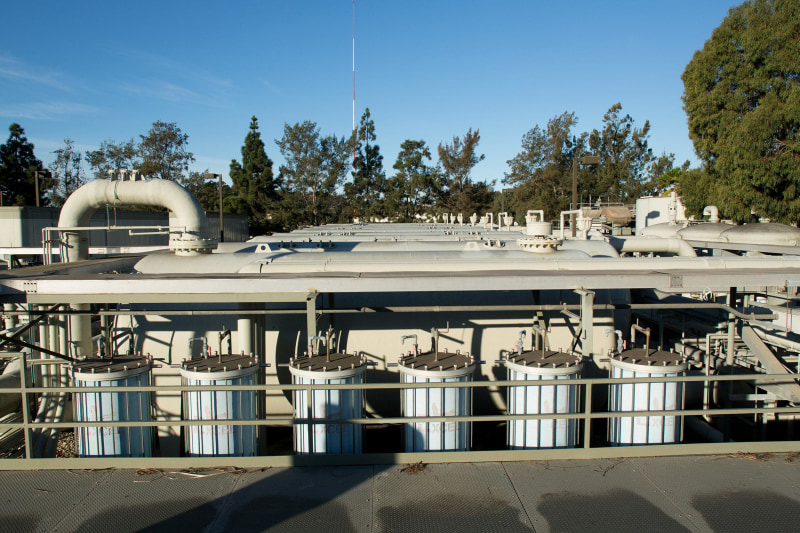Parched California Pours Mega-Millions Into Desalination Tech
By John Roach | NBC NewsFirst published February 17th 2014, 8:22 am
Besieged by drought and desperate for new sources of water, California towns are ramping up plans to convert salty ocean water into drinking water to quench their long-term thirst. The plants that carry out the high-tech "desalination" process can cost hundreds of millions of dollars, but there may be few other choices for the parched state.
Where the Pacific Ocean spills into the Agua Hedionda Lagoon in Carlsbad, Calif., construction is 25 percent complete on a $1 billion project to wring 50 million gallons of freshwater a day from the sea and pour it into a water system that serves 3.1 million people.
Desalination was a dreamy fiction during the California Water Wars of the early 20th century that inspired the classic 1974 movie "Chinatown." In the 1980s, however, the process of forcing seawater through reverse osmosis membranes to filter out salt and other impurities became a reliable, even essential, tool in regions of the world desperate for water.
"I think it will turn out that it is very affordable compared to not having the water here in Southern California, particularly with the drought that we are facing."
The process, however, is energy intensive and thus expensive, making it practical only in places where energy is cheap, such as the oil-rich Middle East. But recent technological advances in membrane materials and energy recovery systems have about halved the energy requirements for desalination, giving the once cost-prohibitive technology a fresh appeal in a state gripped with fear that it may be in the early stages of a decades-long mega-drought.
"I think it will turn out that it is very affordable compared to not having the water here in Southern California, particularly with the drought that we are facing and the fact that the governor has just cut off the flow of water from north to south in the aqueduct, the State Water Project," Randy Truby, the comptroller for the International Desalination Association, an industry advocate, told NBC News.
The multibillion dollar State Water Project is a complex conveyance system that brings water from the wetter northern part of the state to farms, industry, and people in the thirsty south. In times of drought, such as now, banking on that water is a risky bet.
Severe California Drought Draining Finances
Nightly NewsSan Diego's $1 billion bet
In the early 1990s, fears that a drought-induced limit to imported water could leave San Diego County with just a trickle from its scarce local supply prompted the regional water agency to include desalination as part of its long-term strategy, according to Bob Yamada, a planning manager with the San Diego County Water Authority.
Today, the county's Carlsbad Desalination Project under construction is the largest seawater desalter in the Western Hemisphere. When it comes online in 2016, the $1 billion facility will produce enough water to meet the daily needs of 300,000 area residents, which is about 7 percent of the county's water requirements.
That's water, the project backers say, that will no longer have to be imported via the Metropolitan Water District of Southern California, a wholesaler of imported water based in Los Angeles that has a testy relationship with its southern neighbor.
 Carlsbad Desalination Project
Carlsbad Desalination Project But that dash of independence comes at a cost. The water authority is locked into a 30-year deal with the plant's developer, Poseidon Water, to purchase desalted water for about $2,000 an acre foot in 2012 dollars. That's nearly twice as expensive as the current rate for imported water and will add $5 to $7 per month to ratepayers' bills, which is about a 10 percent hike.
The county is making the bet "that even though there is a significant difference right now, those costs will converge in the future [and] that convergence could happen as soon as the early 2020s," Yamada told NBC News. He added that water authority studies found that 68 percent of ratepayers are willing to pay more for a drought-proof water supply.
Cost and environmental concerns
"The trend of imported water (pricing) is definitely going up," Heather Cooley, co-director of the water program at the Pacific Institute, an Oakland-based environmental think tank, told NBC News. "We have some major infrastructure investments needed for imported water in California. I don't have a crystal ball for what it is going to look like, but no doubt it will raise the price of imported water."
The pending price hikes for imported water as well as its uncertain reliability, she explained, are compelling reasons for municipalities to consider desalination. But, she noted, "we can't look at these issues in a vacuum; we have to look at all the options that are available."
WATCH: Parched from Drought, California's Reservoirs Nearly Empty
The sentiment is echoed by the San Clemente, Calif.-based Surfrider Foundation, which has opposed several desalination projects, including Carlsbad, on environmental grounds. For example, sucking up large amounts of seawater can kill fish and other creatures as water passes through intake screens.
"Our general position is there is just a lot more that can be done on both the conservation side and the water recycling side before you get to [desalination] and we feel, in a lot of cases, that we haven't really explored all of those options," Rick Wilson, the organization's coastal management coordinator, told NBC News.
Mothballed in Santa Barbara
A reconsideration of desalination is underway in Santa Barbara, about 185 miles north of Carlsbad, where planners are in the early discussions about investing around $20 million to upgrade and restart a $34 million desalination plant that was constructed there in the early 1990s as a hedge against an ongoing drought, according to Joshua Haggmark, the interim water resources manager for the city.
 John Brecher / NBC News
John Brecher / NBC News Although the plant was permitted and constructed in just two years, it was never brought online. The rains returned and filled area reservoirs just as the desalter was completed. "It was really a challenge to continue and run and operate the facility given the much cheaper surface water," he told NBC News. "The facility was mothballed." In fact, part of it was disassembled and sold to Saudi Arabia.
Bringing it back on line will require a massive overhaul. What's more, "Santa Barbara is a pretty topographically challenged community; there are quite a few different elevations," Haggmark said. Most of the coastal city's water comes via gravity from higher elevation reservoirs. Desalination "comes in at the bottom. You have to lift this water and move this water further up into the system, which is expensive."
"I don't have a crystal ball for what it is going to look like, but no doubt it will raise the price of imported water."
Once infrastructure is factored in, the desalinated water would cost Santa Barbara about $3,000 per acre foot. The facility currently has permits to operate at 3,125 acre-feet per year, which "would basically replace what we are currently getting out of the State Water Project," Haggmark said.
 John Brecher / NBC News
John Brecher / NBC News Sand City Independence
Limited water resources on the Monterey Peninsula hindered master development plans for the small town of Sand City, Calif., which was restricted from any new construction until the city increased its water supply. Regional efforts to find solutions ran into financial and political constraints for more than 20 years. Frustrated, the city struck out on its own to develop a desalination plant.
The city partnered with California American Water for the $14 million project, which started producing 300 acre feet of freshwater a year in 2010. The plant draws brackish water from wells, which is less salty than seawater, meaning its energy requirements are less. The salt content of the leftover brine is about equal the ocean's, so it can be discharged without damaging the marine environment.
The city currently uses about a third of the annual output; the rest is shared among other cities on the water-short peninsula. This allows the water company to reduce its reliance on the stressed Carmel River, which is under state protections.
"Our plant has two benefits, we brought our own water and also we allow the water company to reduce pumping from the illegal source," Sand City Mayor David Pendegrass explained to NBC News. To further alleviate pressures on the river, American Water is pursuing a larger desalination plant on the Monterey Peninsula.
Ultimately, she said, seawater desalination will become part of the solution to California's ongoing water woes — something to consider along with other supply options, including increased wastewater recycling. "The key questions," Cooley said of the desalination plants, "are when do you build them and how large do you build them?"
Source:--
Check out http://groups.yahoo.com/group/californiadisasters/
Read my blog at http://eclecticarcania.blogspot.com/
My Facebook: http://www.facebook.com/derkimster
Linkedin profile: http://www.linkedin.com/pub/kim-noyes/9/3a1/2b8
Follow me on Twitter @DisasterKim
__._,_.___
No comments:
Post a Comment